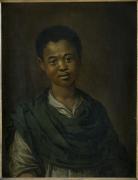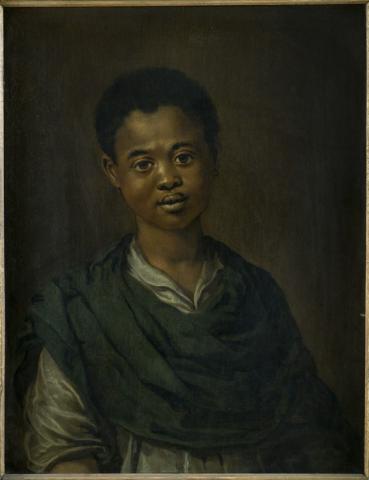Portrait of a young black
In 2000, Dr. Marcel Chatillon, who had worked as a surgeon in Guyana and Guadeloupe, left part of his remarkable collection on the Caribbean to the Museum of Aquitaine. Originating from this collection, the "Portrait of a young black" is a major work, the mysterious and anonymous nature of which is a constant source of questions.
The style of the painting, together with its frame, evoke the Dutch school. Some commentators have suggested that it may have been brought to Guadeloupe by Dutch settlers expelled from Brazil by the Portuguese, which would date it to the middle of the 17th century. However, art historians incline rather to the second half of the 18th century!
Just as astonishing is the theme of the work. Beginning in the 16th century it became common to represent "small black children" in painting. A particularly famous example is the page represented by Titian in 1523 in the portrait of Laura di Dianti. But until the 18th century, it is very rare that these children are represented alone in a painting. They are generally associated with the great lady whom they served. And if they are unaccompanied, the slave's collar they wear leaves no doubt as to their status. This portrait seems therefore to break all of the known rules. This is why the painting has been thought to depict a maroon. This term designated slaves who escaped from the plantations and attempted to create free communities in inhospitable territories. The word comes from the Spanish cimarron, which was itself borrowed from the Arawak language of the Pre-Colombian Caribbean and designated a domestic animal which had returned to the wild. According to the Code Noir drawn up by Colbert in 1685, a slave who escaped once would have an ear mutilated; the second time their hamstring would be cut, and the third time they would be put to death. While on the islands the maroons were easily recaptured, in the vast territories of Brazil, Suriname and French Guiana they succeeded in creating sustainable societies that still exist today; for example in French Guiana in the Boni and Djuka tribes of the valley of Haut Maroni, which takes its name from the same maroons.
Today it is thought that this young black is more likely the son of a planter. The latter often had children with their slaves. If the marriage was legitimate, the child received the status of its father and belonged to the category of "free people of colour", which would explain why his father commissioned an artist to paint this portrait.

